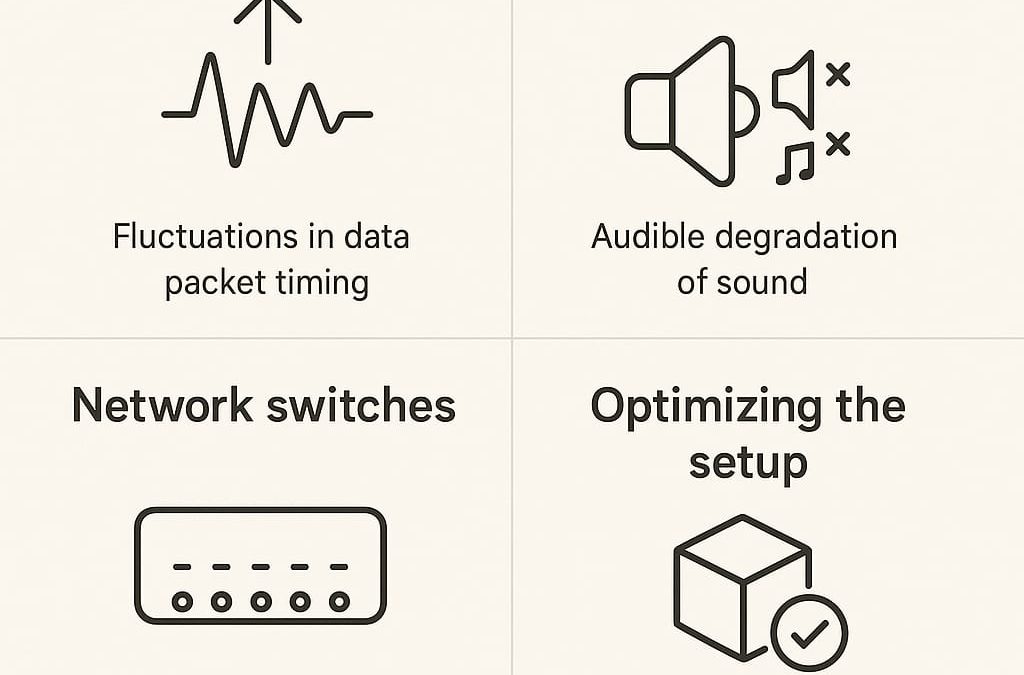Introduction
Digital audio is often considered immune to interference: the ones and zeros either arrive or they don’t. But as we uncovered in Part 1, the timing of those bits — and the electrical noise riding along with them — can have a real, audible impact. This becomes even more critical in streaming systems, where your music traverses routers, switches, Ethernet cables, and USB interfaces before it reaches the DAC. Each of these steps can introduce jitter, EMI, and power noise, subtly degrading the final sound. In this article, we’ll explore how to clean up your digital chain, focusing on high-value upgrades such as audiophile network switches, power supplies, and fiber media converters — all of which help unlock the full potential of your DAC and amplifier.
Part 2: Taming the Digital Chain Experience
Real-world upgrades that reduce noise and jitter in your network for a cleaner, more natural playback experience.
The Bottlenecks in a Digital Audio Chain
Your typical streaming path looks like this:
Internet → Router → (Wi-Fi or Ethernet) → Streamer → DAC → Preamp → Amp → Speakers
While the DAC gets all the attention, the components before it often contribute the most noise.
Common problems include:
- Noisy switching routers and switches
- Unshielded Ethernet cables injecting EMI
- Ground loops between network gear and streamer
- High-frequency noise from switch-mode power supplies
In a well-isolated analog chain, these problems wouldn’t matter — but in streaming setups, they directly affect the clock stability, power rails, and signal integrity of your DAC and streamer.
Why and Audiophile switch makes a difference?
Enter the audiophile-grade Ethernet switch — like the LHY SW-6. Unlike generic plastic switches, these are purpose-built for audio:
- Linear power supplies (LPS) reduce high-frequency ripple and switching noise
- Low phase-noise oscillators (e.g., TCXO or OCXO) provide more stable Ethernet timing
- EMI shielding and ground isolation prevent noise coupling to your streamer
Do they change the bits? No. Do they affect the noise that rides with those bits and can pollute your DAC? Absolutely.
🎧 Real-world result: smoother highs, better separation, cleaner transients, and a more “analog” feel.
Fibre Isolation: Cutting the Noise at the source
One of the most effective — and overlooked — upgrades in networked audio is galvanic isolation using fiber. By inserting Fiber Media Converters (LHY FMCs) between your router and switch, you break the electrical link entirely. These blocks:
- Ground loops
- Common-mode noise
- High-frequency interference from routers, modems, and ISP gear
🛠️ Typical Setup:
Router → FMC (Ethernet to Fiber) → Fiber Cable → FMC (Fiber to Ethernet) → Audiophile Switch → Streamer
Pro Tip: Use low-noise LPS units to power each FMC for maximum benefit.
Power Supply Quality: More than Just Amps
Most digital gear is powered by a cheap switch-mode PSUs that introduce:
- High-frequency noise into power rails
- Poor voltage regulation
- Ground pollution
Upgrading to a low-noise linear power supply (like those bundled with the LHY SW-6 or external options from Keces, SBooster, or Ferrum) or a higher quality switch mode power supply ensures:
- Stable voltage delivery
- Low EMI emissions
- Cleaner analog stage behavior in streamer/DACs
A good rule: if it’s in your audio chain — power it cleanly.
Prioritising Upgrades: What matters most?
If you’re building or improving your digital front-end, here’s how to prioritize based on value and impact:
| Priority | Upgrade | Impact |
| 1 | Replace Wi-Fi with wired Ethernet | Stability + lower RF noise |
| 2 | Add FMC between router and switch | Total electrical isolation |
| 3 | Upgrade to audiophile switch (e.g., LHY SW-6) | Lower EMI, better timing |
| 4 | Use LPS for switch, streamer, and FMCs | Cleaner power = cleaner sound |
| 5 | Use shielded, high-quality Ethernet | Reduces EMI ingress |
Bonus: For sensitive systems, optical Ethernet modules, DC filters, or clock-synced gear may yield even more improvement.
Wrapping Up
The idea that “bits are just bits” only holds true when timing and electrical environment are ideal — which they rarely are in real-world hi-fi setups. Each step you take to isolate, clean, and stabilize the digital path helps your DAC do its job with greater precision and less interference. In Part 3, we’ll look further down the chain — from the streamer’s USB output to DDCs, I²S connections, and master clock synchronization — to show how much sonic improvement is still on the table after the network side is optimized.

